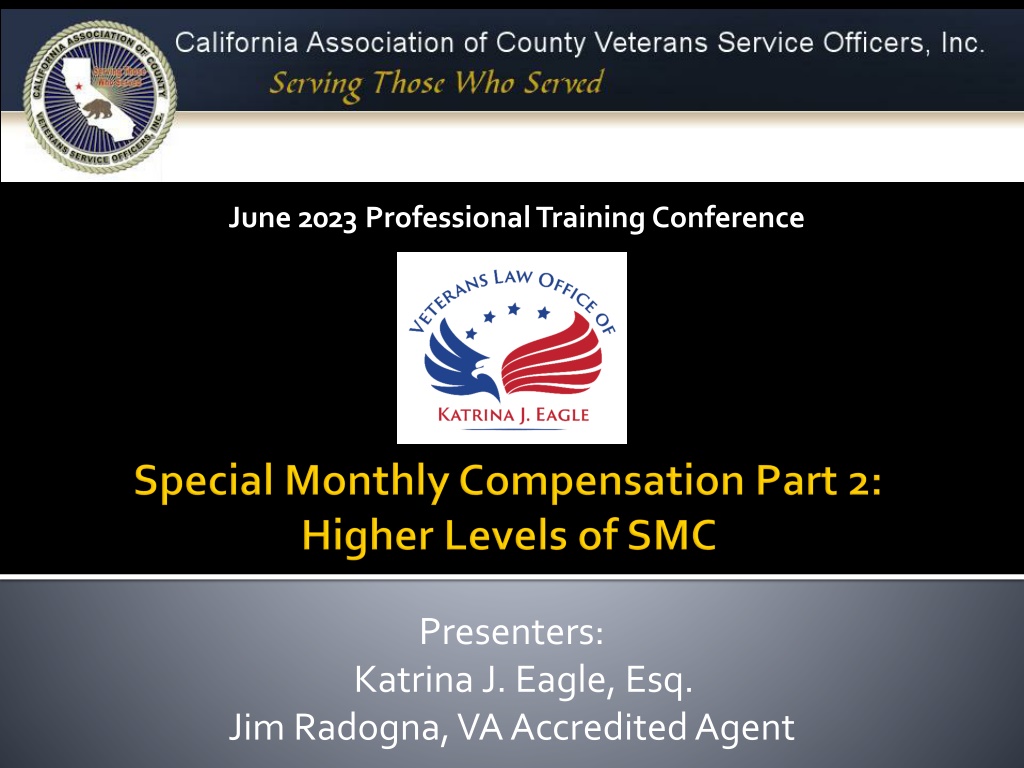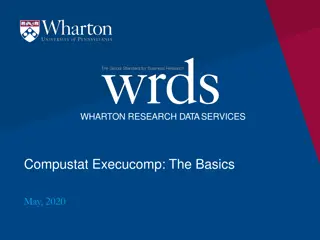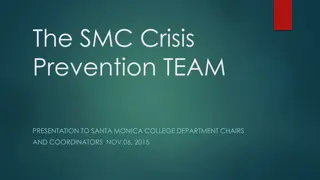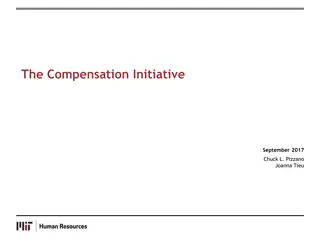Understanding Special Monthly Compensation (SMC) Levels and Benefits
Special Monthly Compensation (SMC) offers various levels of benefits based on the extent of service-related disabilities, such as anatomical losses, blindness, and aid and attendance needs. Veterans may receive different SMC levels like SMC-K, L, M, N, and O depending on the severity and combination of disabilities. The levels vary for upper extremities (hand, elbow, shoulder) and lower extremities (foot, knee, hip), with specific criteria determining the compensation amount. Understanding these levels is crucial for veterans to maximize their entitled benefits.
Download Presentation

Please find below an Image/Link to download the presentation.
The content on the website is provided AS IS for your information and personal use only. It may not be sold, licensed, or shared on other websites without obtaining consent from the author. Download presentation by click this link. If you encounter any issues during the download, it is possible that the publisher has removed the file from their server.
E N D
Presentation Transcript
Spring 2023 Professional Training Conference Winter 2023 Professional Training Conference June 2023 Professional Training Conference Presenters: Katrina J. Eagle, Esq. Jim Radogna, VA Accredited Agent
+$884.89 +$1,117.88 +$1,351.81 +$1,693.56 +$2,036.07 +$2,368.89 +$2,702.31 +$5,414.94 +$6,753.58 +$432.17 SMC-K amount is paid in addition to regular monthly compensation ($3,621.95 + $128.62), all other levels are in place of regular monthly compensation. 2
The higher levels of SMC, L through O, and special aid and attendance benefits (R1 and R2), are payable for combinations of anatomical loss or loss of use of the extremities at different levels, blindness, and regular aid and attendance. If a veteran is entitled to SMC-L, M, or N, and also has established entitlement to SMC-K on another basis, he or she will continue to receive SMC-K compensation for that disability. The combined compensation rate of Level K + Level L/M/N can t exceed the amount given under the next SMC Level. For instance, SMC-L + multiple SMC-Ks can t exceed the amount paid for SMC-M. There are seven levels of SMC between SMC-L and SMC-O: SMC-L, SMC-L1/2, SMC-M, SMC-M1/2, SMC-N, SMC-N1/2 and SMC-O. SMC-P establishes the intermediate levels (L , M , etc.). 3
As we mentioned in part 1, when a veteran suffers a single loss, say loss of use of a foot, only one level of SMC is payable, which is SMC-K. It doesn't matter whether the loss is at the foot, knee or hip; only SMC-K may be paid for a single extremity loss. This changes for higher levels of SMC where the location of anatomical loss/loss of use or degree of vision loss can make a substantial difference in the amount of special monthly compensation a veteran receives. Let s take a look at the different levels of loss 4
For the upper extremities there are three levels - hand, elbow, and shoulder. Any anatomical loss or loss of use below the elbow is considered the hand level. The elbow level requires an above elbow amputation or loss of natural elbow action. To be considered at the shoulder level, there must be an anatomical loss. This means that there must be an amputation, and so high as to prevent the wearing of a prosthesis. There is no loss of use level at the shoulder, only anatomical loss. 5
There are three primary levels of loss for the lower extremities - the foot, knee, and hip. An amputation below the knee or loss of use of the foot is considered a loss at the foot level. To be considered at the knee level, there must be a loss of natural knee action or an above the knee amputation. A loss at the hip level is established by amputation so high as to prevent the wearing of prosthesis. There is no loss of use level at the hip, only anatomical loss. 6
There are three primary levels of loss of vision (blindness): Visual Acuity of 5/200 or less Light Perception Only (LPO) No Light Perception (NLP) The anatomical loss of an eye, or enucleation, is considered the same level of disability as no light perception. 7
The following combinations of loss/loss of use for lower and upper extremities and vision loss will entitle a veteran to SMC-L: Anatomical loss or loss of use of both feet. Anatomical loss or loss of use of one hand and one foot. Blindness in both eyes with vision 5/200 or less or the visual field restricted to 5 degrees or less. SMC-L is also available to a veteran who is: Permanently bedridden, or In need of aid and attendance (A&A) 38 U.S.C. 1114(l); 38 C.F.R. 3.350(b) The following SMC descriptions are examples and do not necessarily encompass all possibilities for each SMC level 8
The following combinations of loss/loss of use of lower and upper extremities and vision loss will entitle a veteran to SMC-M: Anatomical loss or loss of use of both hands (i.e., below the elbow loss) Anatomical loss or loss of use of both legs at a level, or with complications preventing natural knee action with prostheses in place (i.e., above the knee loss) Anatomical loss or loss of use of one upper and one lower extremity preventing natural elbow and knee action due to the level of involvement or with complications, with prosthesis in place (i.e., above the knee or elbow loss) Loss or Loss of Use of Leg Below Knee + Loss of Leg Near Hip Loss or Loss of Use of Leg Below Knee + Loss of Arm Near Shoulder Loss of Leg Near Hip + Loss or Loss of Use of Hand Blindness in both eyes having light perception only (LPO) Blindness, 5/200 bilateral, leaving the veteran so helpless as to be in need of A&A Blindness, 5/200 bilateral plus 30% bilateral deafness or loss/LOU of hand or foot Blindness, 5/200 one eye and NLP other eye Blindness, 5/200 one eye and LPO other eye w/ total deafness one ear or loss of use one foot (rated as less than 50%) 38 U.S.C. 1114(m); 38 C.F.R. 3.350(c) 9
The following combinations of loss or loss of use for the lower and upper extremities and vision loss will entitle a veteran to SMC-N: Loss or Loss of Use of Arm Above Elbow + Loss or Loss of Use of Arm Above Elbow Loss or Loss of Use of Hand + Loss of Arm Near Shoulder Loss of Leg Near Hip + Loss of Leg Near Hip (amputation is prerequisite) Loss of Leg Near Hip + Loss of Arm Near Shoulder (amputation is prerequisite) Vision: No Light Perception + Vision: No Light Perception LPO one eye + NLP and bilateral deafness (10 0r 20%) OR LOU of foot (less than 50%) NLP both eyes + bilateral deafness (30% or more) OR Loss/LOU of hand or Loss/LOU of foot (more than 50%) 5/200 one eye + LPO other eye plus bilateral deafness (30% or more) 5/200 bilateral + A&A + bilateral deafness (30% or more) OR Loss/LOU of hand or Loss/LOU of foot (more than 50%) 10 38 U.S.C. 1114(n); 38 C.F.R. 3.350(d)
The following combination of loss for the upper extremity will entitle a veteran to SMC-O: Loss of Arm Near Shoulder + Loss of Arm Near Shoulder Bilateral deafness rated at 60% + bilateral visual acuity of 20/200 or less Bilateral deafness rated at 40% + bilateral light perception only Total deafness in one ear and bilateral light perception only Bilateral NLP + 30% bilateral deafness OR loss/LOU hand OR LOU foot (50% +) Conditions entitling the veteran to two or more of the SMC rates L through N, with no condition being considered twice (NOTE: this is generally the easiest path to entitlement to SMC-O). Example: The veteran has bilateral LOU above knees and is entitled to SMC-M. The veteran is also entitled to SMC-L due to service-connected blindness in both eyes with vision 5/200 . Because the veteran meets the requirements for two SMC rates L through N and no condition was considered twice, he is entitled to SMC-O. 11
SMC-O from a combination of two or more of the SMC rates L through N must be based upon separate and distinct disabilities. For example, where a veteran who had suffered the loss or loss of use of two extremities is being considered for SMC-O on account of helplessness requiring regular aid and attendance, the latter must be based on need resulting from pathology other than that of the extremities. However, the fact that two separate and distinct entitling disabilities, such as anatomical loss, or loss of use of both hands and both feet, resulting from a common etiological agent, such as one injury or rheumatoid arthritis, will not preclude maximum entitlement under O. For example, veteran has bilateral below the knee amputations due to diabetes. This entitles veteran to SMC-L. The veteran also suffered a stroke due to diabetes and because of the stroke, lost the use of both hands. This gives a second rate under M, thus establishing entitlement to SMC-O. 12
Entitlement to SMC-O can also be based on the combination of loss of use of extremities and helplessness: Paraplegia (paralysis of both lower extremities) together with loss of anal and bladder sphincter control. The requirement of loss of anal and bladder sphincter control is met even though incontinence has been overcome under a strict regimen of rehabilitation of bowel and bladder training and other auxiliary measures. Helplessness will also be held to exist with conditions such as the loss of use of two extremities with absolute deafness and nearly total blindness or with severe multiple injuries producing total disability outside the useless extremities, these conditions being considered as loss of use of two extremities and helplessness. 13
SMC-P provides authority for the VA to award intermediate or next higher statutory SMC rates for increased levels of loss/loss of use (i.e., L , M , N ). These rates are referred to as 1/2 step and full-step increases. In no event will the step increases be to a rate higher than the rate under SMC-O. SMP-P also awards increased levels for some combinations of blindness and hearing loss, blindness and loss of use of an extremity, additional independent 50% or 100% evaluations, and loss of three extremities. (These increased levels pay the same amount of compensation as SMC-O). SMC-P rates can never exceed that of SMC-O. 38 U.S.C. 1114(p); 38 C.F.R. 3.350(f) 14
Combinations of blindness and deafness will result in either an additional half- step or full-step increase in compensation, depending on the level of service- connected blindness and severity of the hearing loss. The criteria for determining the appropriate level of increase are contained in 38 CFR 3.350(f)(2)(iv) through 38 CFR 3.350(f)(2)(vi) as well as in 38 CFR 3.350 (e)(1)(iii) and (e)(1)(iv). 38 CFR 3.350(f)(2)(vii) (A)(B) and (C) show the various combinations of blindness and loss of use of an upper or lower extremity. 38 CFR 3.350(f)(3) states that if a veteran has additional and different independent disabilities rated 50% or more, then he or she is entitled to the next higher intermediate rate (half-step). 38 CFR 3.350(f)(4) states that if a veteran has additional and different independent disabilities rated 100%, he or she is entitled to the next higher statutory rate (full-step). The 50% under 3.350(f)(3) may be a combination of unrelated disabilities but the 100% under 3.350(f)(4) must be a single disability BUT for this purpose, a single disability is defined in accordance with 38 CFR 4.16 the same as for TDIU. 15
Concurrent entitlement to SMC under both 38 CFR 3.350(f)(3) and 38 CFR 3.350(f)(4) is prohibited. In other words, the veteran can t get both a half step bump for 50% and a full step bump for 100%. Disability evaluations used to support entitlement to half and full step bumps must be permanent. Elevated rates may also be authorized for the loss or loss of use of three extremities. If a veteran has suffered the service-connected loss or loss of use, or a combination of anatomical loss or loss of use, of three extremities, he/she is entitled to the next higher rate regardless of whether that rate is a statutory rate or an intermediate rate. For example, if a veteran has loss of use of both hands and one foot, he would be entitled to SMC-M for the hands and a one-half step elevation due to the triple extremity plus SMC-K for the foot (i.e., paid SMC-M1/2 plus SMC-K). 16
Example involving 38 CFR 3.350(f)(3): Veteran has anatomical loss of both lower extremities that meets the requirements for SMC-M (above knee) and a 70% permanent SC evaluation for PTSD that is completely independent of the anatomical loss of both lower extremities. Result:the Veteran is entitled to the intermediate rate of SMC-M1/2, because of additional and different independent disabilities rated 50% or more. Example involving 38 CFR 3.350(f)(4): Veteran has anatomical loss of both lower extremities that meets the requirements for SMC-M (above knee) and a 100% permanent SC evaluation for PTSD that is completely independent of the anatomical loss of both lower extremities. Result: the Veteran is entitled to the next higher rate of SMC-N, because of the additional, single, permanent disability that is independently ratable as 100- percent disabling. 17
Example involving a multisystem disorder: A Veteran has lost the use of both lower extremities due to SC multiple sclerosis (entitlement to SMC-L) She also has the following other disabilities due to multiple sclerosis: Dysarthria @ 30% Impairment of anal sphincter control @ 10% Loss of bladder control at 10% Nystagmus @ 10% Result:the Veteran is entitled to the intermediate rate of SMC-L1/2, because of additional and different independent disabilities rated 50% or more. NOTE: If this veteran had loss of use of both anal and bladder sphincter control, she would be entitled to SMC-O 18
SMC-Q is a protected rate that hasnt been awarded since August 19, 1968. SMC-Q is payable for those veterans who had a non-compensable evaluation for inactive tuberculosis prior to August 19, 1968, when there is no other compensation payable. It is currently $67.00. 19
The following combinations of loss or loss of use for the lower and upper extremities and vision loss will entitle a veteran to SMC-L1/2: Loss or Loss of Use of Leg Above the Knee or At a Level with Complications Preventing Natural Knee Action with Prosthesis in Place + Loss or Loss of Use of Leg Below Knee Loss or Loss of Use of Leg Below Knee + Loss or Loss of Use of Arm Above Elbow or At A Level with Complications Preventing Natural Elbow Action with Prosthesis in Place Loss or Loss of Use of Leg Above the Knee or At a Level with Complications Preventing Natural Knee Action with Prosthesis in Place + Loss or Loss of Use of Hand Vision: 20/ 200 + Vision: Light Perception Only 20/ 200 vision + loss of use of one foot (rated at less than 50%) Example: Veteran has amputation of the left leg below the knee and loss of use of the right leg at a level with complications preventing natural knee action with prosthesis in place. 21
The following combinations of loss or loss of use for the lower and upper extremities and vision loss will entitle a veteran to SMC-M1/2. Loss or Loss of Use of Leg Above Knee + Loss Leg Near Hip Loss Loss of Use of Leg Above Knee + Loss of Arm Near Shoulder Loss Loss of Use of Arm Above Elbow + Loss of Leg Near Hip Loss Loss or Loss of Use of Hand + Loss or Loss of Use of Arm Above Elbow Vision: Light Perception Only + Vision: No Light Perception LPO in both eyes + Loss of Use of one foot (rated at less than 50%) Combinations of blindness + deafness or blindness + extremity loss/LOU Blindness + A&A + Loss of Use of one foot (rated at less than 50%) Example: The veteran has amputation of the left hand and loss of use of the right hand with complications preventing natural elbow action with prosthesis in place. 22
The following combination of loss or loss of use of the upper extremity will entitle a veteran to SMC-N1/2: Loss or Loss of Use Arm Above Elbow + Loss of Arm Near Shoulder NLP in Both Eyes + Loss of Use of one foot (rated at less than 50%) Combinations of blindness + deafness or blindness + extremity loss/LOU Note: If 3 SMC-Ks were added to SMC-N1/2, it would exceed the SMC-O amount so the amount would be capped at the SMC-O rate. 23
SMC-R1 and R2 are considered special aid and attendance benefits and an extension of SMC-O. A Veteran is entitled to SMC-R1 when he or she is receiving SMC-O, SMC-P at a rate equal to SMC-O, or SMC-N1/2 plus SMC-K AND is entitled to regular aid and attendance under SMC-L. SMC-R1 is payable whether or not the need for aid and attendance was a partial basis for entitlement to the maximum rate under SMC-O. In other words, the same A&A can be a basis for entitlement to SMC-O and also the basis for entitlement to SMC-R1 (This is a rare instance where VA allows pyramiding!). Example: The veteran has loss of use of both feet. Additionally, as the result of PTSD, he is a danger to himself and in need of regular A&A. The veteran is entitled to SMC-L for loss of use of both feet. Because of the need for regular A&A, he is entitled to another SMC-L, Because he meets the requirements for two SMC rates L through N and no condition was considered twice, he is entitled to O. Because he has entitlement to SMC-O and because he already meets the requirements for regular A&A under SMC-L, he is entitled to SMC-R1. 38 U.S.C. 1114(r)(1); 38 C.F.R. 3.350(h) 24
For a higher level of special aid and attendance, which is SMC-R2, all of the following conditions must be met: The veteran is entitled to compensation authorized under SMC-O, SMC-P at a rate equal to SMC-O, or SMC-N1/2 plus SMC-K. The veteran meets the requirements for entitlement to the special aid and attendance requirements under R1. The veteran needs a "higher level of care" than is required to establish entitlement to R1 and, in the absence of the provision of such higher level of care, the veteran would require hospitalization, nursing home care, or other residential institutional care. 38 U.S.C. 1114(r)(2); 38 C.F.R. 3.350(h) 25
Need for a higher level of care shall be considered to be need for personal health-care services provided on a daily basis in the veteran's home by a person who is licensed to provide such services or who provides such services under the regular supervision of a licensed health-care professional. Personal health-care services include (but are not limited to) such services as physical therapy, administration of injections, placement of indwelling catheters, and the changing of sterile dressings, or like functions which require professional health-care training or the regular supervision of a trained health-care professional to perform. A licensed health-care professional includes (but is not limited to) a doctor of medicine or osteopathy, a registered nurse, a licensed practical nurse, or a physical therapist licensed to practice by a State or political subdivision thereof. 26
The term under the regular supervision of a licensed health-care professional means that an unlicensed person performing personal health- care services is following a regimen of personal health-care services prescribed by a health-care professional, and that the health-care professional consults with the unlicensed person providing the services at least once each month to monitor the prescribed regimen. The consultation need not be in person; a telephone call will suffice. The higher-level aid and attendance allowance is to be granted only when the veteran's need is clearly established and the amount of services required by the veteran on a daily basis is substantial. Entitlement to the higher A&A allowance may be awarded when an otherwise eligible Veteran is receiving residential or nursing-home care in an institution at the Veteran s own expense. 38 CFR 3.352(b)(3) 27
Formerly, VA required that a veteran's need for a "higher level of care" must be determined by a VA physician or, in areas where no VA physician is available, by a physician carrying out such function under VA contract or fee arrangement based on an examination by such physician. However, this has changed. Evidence of need for a higher level of care from a private medical professional can now be submitted. The evidence of record must indicate: An ongoing need for skilled personal care and, In the absence of such care, the Veteran would require hospitalization, nursing home care, or other residential institutional care. Entitlement may be established by evidence which shows: The conditions justifying the need for this level of care Nature, extent, and frequency of the services provided, and Nature and extent of the supervision being provided, if the services are actually provided by a nonprofessional. 28
In 2011, Congress recognized that the disabilities caused by TBI can be as profound as those caused by the loss of limbs, blindness, etc. As such, SMT-T pays the same amount of compensation as SMC-R2 even though the veteran wouldn t qualify otherwise. So, what does it take to qualify for SMC-T? 29
The statute 38 U.S.C. 1114(t) states: if any veteran, as the result of service- connected disability, is in need of regular aid and attendance for the residuals of traumatic brain injury, is not eligible for compensation under subsection (r)(2), and in the absence of such regular aid and attendance would require hospitalization, nursing home care, or other residential institutional care, the veteran shall be paid, in addition to any other compensation under this section, a monthly aid and attendance allowance equal to the rate described in subsection (r)(2) So, according to the statute, it appears that a veteran would not need a higher level of care like that required by SMC-R2 right? BUT, the regulation 38 C.F.R. 3.350(j) states: "The special monthly compensation provided by 38 U.S.C. 1114(t) is payable to a veteran who, as the result of service-connected disability, is in need of regular aid and attendance for the residuals of traumatic brain injury, is not eligible for compensation under 38 U.S.C. 1114(r)(2), and in the absence of such regular aid and attendance would require hospitalization, nursing home care, or other residential institutional care. Determination of this need is subject to the criteria of 38 C.F.R. 3.352." 30
38 CFR 3.352(b)(2) states: "A veteran is entitled to the higher level aid and attendance allowance authorized by 3.350(j) in lieu of the regular aid and attendance allowance when all of the following conditions are met: (i) As a result of service-connected residuals of traumatic brain injury, the veteran meets the requirements for entitlement to the regular aid and attendance allowance in paragraph (a) of this section. (ii) As a result of service-connected residuals of traumatic brain injury, the veteran needs a higher level of care (as defined in paragraph (b)(3) of this section) than is required to establish entitlement to the regular aid and attendance allowance, and in the absence of the provision of such higher level of care the veteran would require hospitalization, nursing home care, or other residential institutional care. 38 CFR 3.352(b)(3) states: Need for a higher level of care shall be considered to be need for personal health-care services provided on a daily basis in the veteran's home by a person who is licensed to provide such services or who provides such services under the regular supervision of a licensed health-care professional. 31
Although 38 CFR 3.352(b)(2) states that the veteran must be in need of a higher level of care (i.e., daily health care services by a health care professional), the BVA and AOJ have sometimes granted SMC-T despite the fact that the veteran does not meet this criteria. Here s why: the M21 doesn t mention the need for a higher level of care: When the Veteran is entitled only to regular A&A due to TBI, but would require hospitalization, nursing home care, or other residential institutional care in the absence of regular A&A, the Veteran should be paid at the basic code in the absence of other qualifying disabilities. (M21 VIII.iv.4.A.11.e) While the BVA isn t bound by the M21, it appears that some judges don t delve too far into the regulation regarding the need for a higher level of care. So, in some situations it appears that SMC-T can be easier to achieve than R2. A strong independent medical opinion that the veteran would need to be hospitalized absent regularA&A may be enough 32
When a veteran is hospitalized at the expense of the U.S. government, the additional aid and attendance allowance authorized under R1, R2 or T will be discontinued effective the last day of the month following the month in which the veteran is admitted for hospitalization. The SMC allowance for A&A will be discontinued during hospitalization at government expense, unless the need for A&A is due to: Paraplegia involving paralysis of both lower extremities, together with loss of anal and bladder sphincter control, or Hansen s disease SMC-L, M or N may also be discontinued during hospitalization and the rates may be reduced to that of a lower level of SMC (See 38 CFR 3.552). 33
38 CFR 3.383 Special consideration for paired organs and extremities. (a) Entitlement criteria. Compensation is payable for the combinations of service-connected and nonservice-connected disabilities specified in paragraphs (a)(1) through (a)(5) of this section as if both disabilities were service-connected, provided the nonservice-connected disability is not the result of the veteran's own willful misconduct. (1) Impairment of vision in one eye as a result of service-connected disability and impairment of vision in the other eye as a result of non-service-connected disability and (i) The impairment of vision in each eye is rated at a visual acuity of 20/200 or less; or (ii) The peripheral field of vision for each eye is 20 degrees or less. (2) Loss or loss of use of one kidney as a result of service-connected disability and involvement of the other kidney as a result of nonservice-connected disability. (3) Hearing impairment in one ear compensable to a degree of 10 percent or more as a result of service-connected disability and hearing impairment as a result of nonservice-connected disability that meets the provisions of 3.385 in the other ear. (4) Loss or loss of use of one hand or one foot as a result of service-connected disability and loss or loss of use of the other hand or foot as a result of nonservice-connected disability. (5) Permanent service-connected disability of one lung, rated 50 percent or more disabling, in combination with a nonservice-connected disability of the other lung. 34
Point Totals: Loss/LOU below elbow or knee (hand or foot) = 1 point Loss/LOU above elbow or knee = 2 points Loss/LOU near shoulder or hip = 3 points Loss/LOU of both hands or arms = 2 extra points Vision 5/200 or less = 1 point Vision light perception only = 2 points Vision no light perception or enucleation = 3 point Additional single or combined permanent disabilities rated at 50% - 1 extra point Additional single disability rated at 100% - 2 extra points 35
First, determine if there is a combination of loss: Both hands/arms Both feet/legs A hand/arm and a foot/leg Visual impairment in both eyes* *Vision impairment may not be combined with loss/LOU of extremities Then, if there is a combination of loss as stated above, add points to determine SMC level: SMC-L = 2 points SMC-L1/2 = 3 points SMC-M = 4 points SMC-M1/2 = 5 points SMC-N = 6 points SMC-N1/2 = 7 points SMC-O = 8 points (NOTE: SMC-O can also be assigned if there are 2 awards of L thru N1/2) 36
Example #1: Loss of left leg above knee = 2 points Loss of use of right hand = 1 point Total is 3 points = SMC-L1/2 Example #2: Anatomical loss of right arm near shoulder = 3 points Loss of use of left hand = 1 point 2 extra points for loss of use of both hands Loss of use of right foot = 1 point Total is 7 points = SMC-N1/2 37
Example #3: Anatomical loss of left arm above elbow = 2 points Loss of use of right hand = 1 point 2 extra points for loss of use of 2 hands Visual acuity of 5/200 in right eye = 0 points because visual impairment can t be combined with extremity loss Total is 5 points = SMC -M1/2 plus SMC-K for 5/200 in right eye Example #4: Anatomical loss of right arm near shoulder = 3 points Loss of use of left hand = 1 point 2 extra points for loss of use of both hands Loss of use of right foot = 1 point Additional combined permanent disabilities rated at 50% = 1 point Total is 8 points = SMC-O 38
SMC, especially at the higher levels, is extraordinarily complex. As a result, VA raters often commit errors when determining a veteran s accurate entitlement. Entitlement to SMC is an inferred issue and VA s failure to properly award SMC could be a clear and unmistakable error in a final decision. But VA can only infer SMC if they are aware of the veteran s current condition. That s why it s incumbent on advocates to ask their veterans to keep them apprised of any future loss of uses, etc. Veterans suffering from degenerative diseases such as Parkinson s, Multiple Sclerosis or even Diabetes may eventually qualify for higher levels of SMC as their conditions worsen. Keep in mind that a veteran can be entitled to more than one SMC-L for Aid and Attendance. For instance, a veteran could require A&A for the residuals of Parkinson s AND also separately require A&A for his/her 100% service- connected PTSD. This can be a basis for R1 or R2 entitlement for a veteran who may not have the requisite loss of extremities or blindness but is still severely disabled. 40
Feel free to contact us about questions from this training or ANYTIME you have a question about a claim: CACVSO@eagleveteranslaw.com 42






















